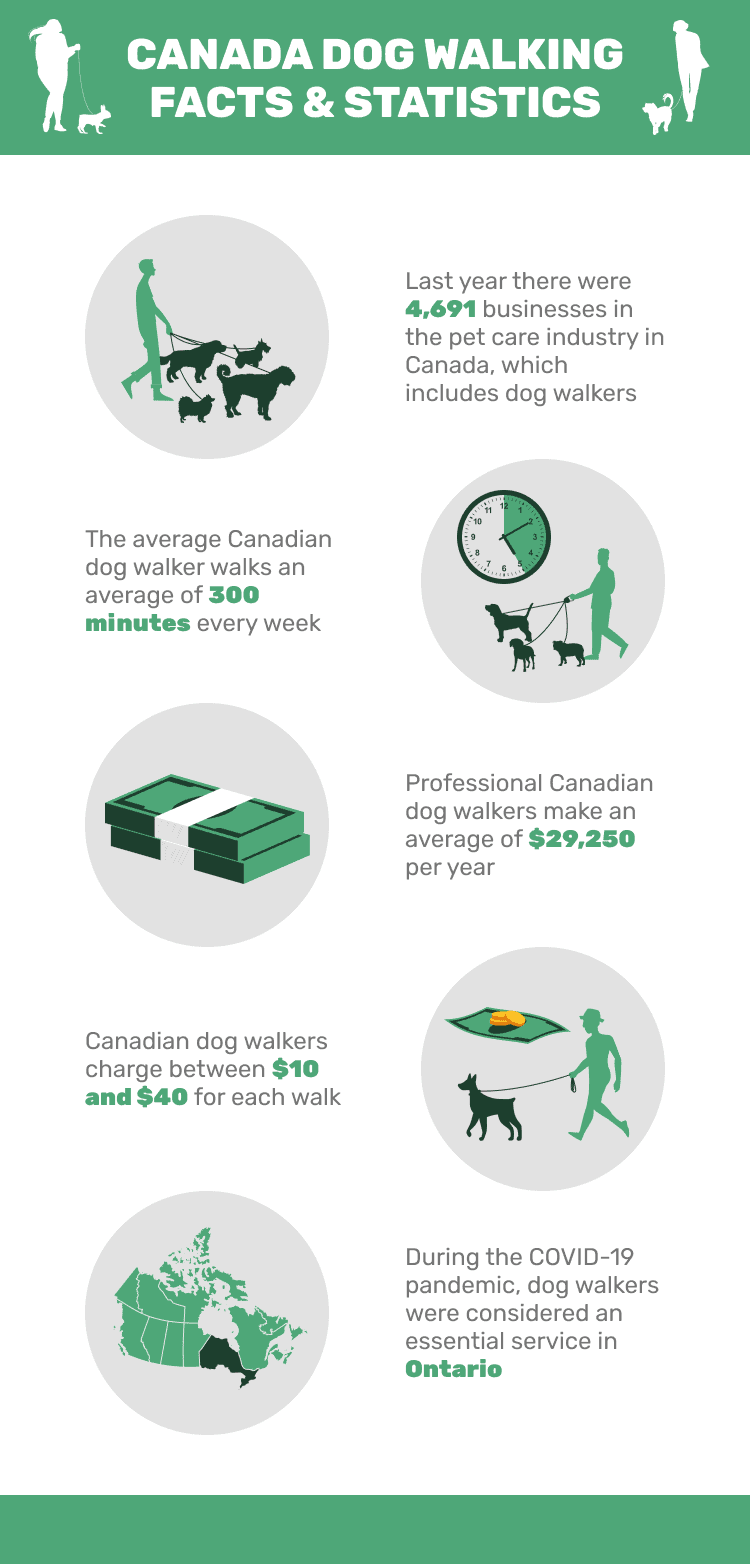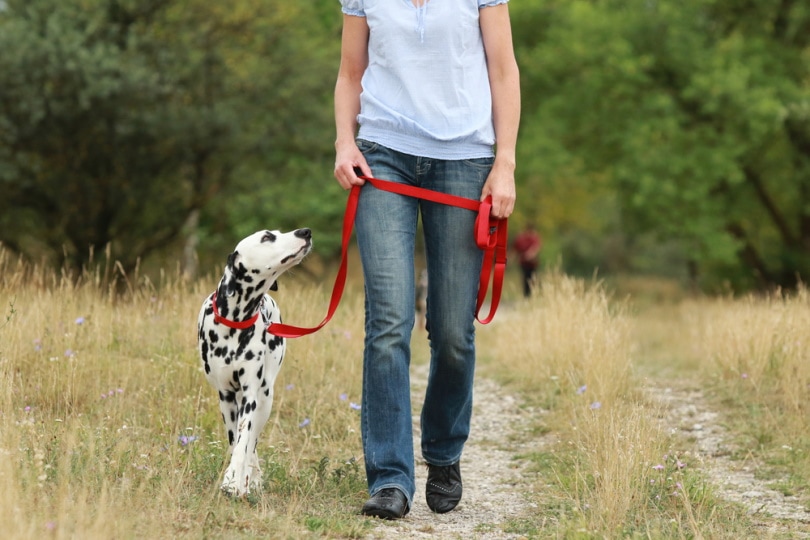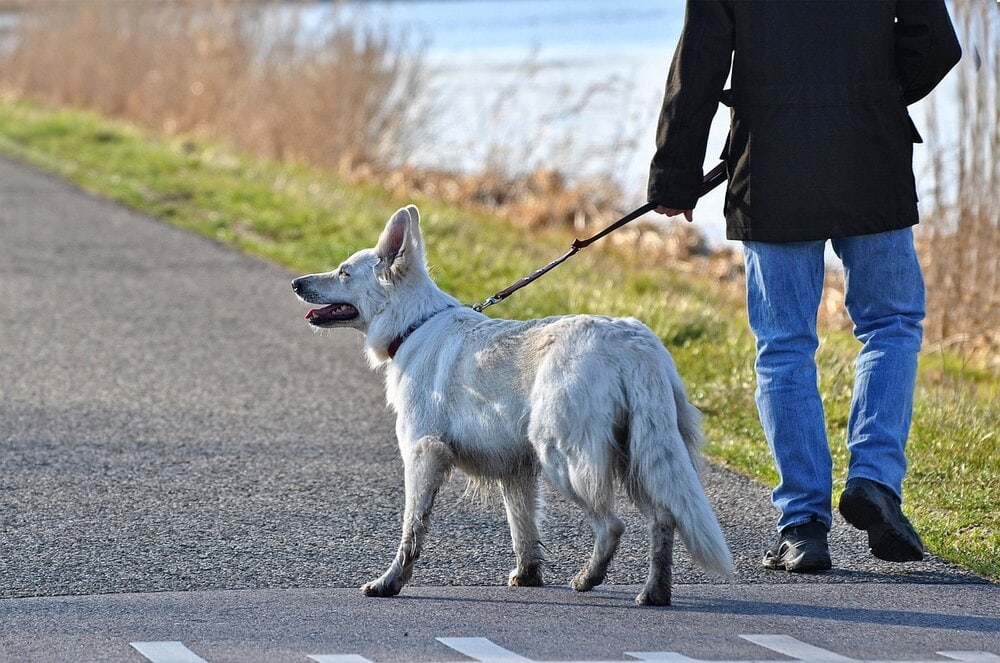Click to Skip Ahead
Note: This article’s statistics come from third-party sources and do not represent the opinions of this website.
One question that a potential dog owner should ask is how much exercise their new dog will need. If you want a dog that fits into your lifestyle, you should do your research on the breed first.
Walking your dog is a necessity, but sometimes life gets in the way, so you might find yourself considering asking a friend for help or hiring a professional dog walker. The most important thing is that your dog gets their daily exercise.
Since dog walking is such an integral part of taking care of a dog, here are interesting and potentially helpful statistics about dog walking in Canada.
Top 10 Canada Dog-Walking Statistics
- In 2022, approximately 7.9 million Canadians owned pet dogs.
- In 2022, there were 4,691 businesses in the pet care industry in Canada, which includes dog walkers.
- In 2019, 90% of Canadian homes had greenspace within 10 minutes of their homes.
- The average dog walker walks an average of 300 minutes every week.
- Canadians with dogs walk an average of four times a day.
- Dog walking has a positive effect on mental health.
- Professional Canadian dog walkers make an average of $29,250 per year.
- Canadian dog walkers charge between $10 to $40 for each walk.
- During the COVID-19 pandemic, dog walkers were considered an essential service in Ontario.
- People returning to work after the pandemic caused an increased demand of 137% for dog walkers.

Dog Walking Statistics
1. In 2022, approximately 7.9 million Canadians owned pet dogs.
(Financial Post)
This statistic was taken from a nationwide survey, and it also states that cats outnumber dogs in Canada. In 2022, there are about 8.5 million cats. From 2020 to 2022, 200,000 dogs were adopted primarily due to the COVID-19 pandemic.

2. In 2022, there were 4,691 businesses in the pet care industry in Canada, which includes dog walkers.
(Statistics Canada)
These businesses also include pet sitters, animal shelters, trainers, and groomers.
3. In 2019, 90% of Canadian homes had greenspace within 10 minutes of their homes.
(Statistics Canada)
The most popular activity for Canadians in 2019 was walking. About 72% of Canadians walked to these close-by parks and greenspaces, many with their dogs by their sides.

4. The average dog walker walks an average of 300 minutes every week.
(Research Gate)
This statistic is based out of Victoria, B.C., and the study found that compared to the average of 300 minutes a week for dog walkers, those without dogs spent an average of 168 minutes walking. Dogs are a great way to get more exercise!
5. Canadians with dogs walk an average of four times a day.
(CBC)
Canadians are recommended to get a minimum of 1 hour and 50 minutes of exercise every day. Dog walkers do at least 10 minutes more walking than this.

6. Dog walking has a positive effect on mental health.
(Frontiers)
A 2021 study found that not only does dog walking provide physical exercise, but it also keeps us mentally healthy. Your blood flow and circulation increase in the body and the brain, which helps boost your mood. Walking is also known to help with depression.
Professional Dog Walker Statistics
7. Professional Canadian dog walkers make an average of $29,250 per year.
(Talent)
This annual salary works out to about $15 an hour, but how much you make depends on how many dogs you walk and how long you walk them. Entry-level positions might start at $25,545, and experienced dog walkers could make up to $50,850 annually.

8. Canadian dog walkers charge between $10 to $40 for each walk.
(Finder)
The longer they walk, the more they make. 30-minute walks will cost less compared to walks that are 1 hour or more. Additionally, dog walkers in more densely populated cities, such as Vancouver or Toronto, will charge more than those in smaller cities and towns.
9. During the COVID-19 pandemic, dog walkers were considered an essential service in Ontario.
(CP24)
This was accomplished with a petition signed by just over 5,700 dog owners asking the provincial government to call dog walking an essential service, which was granted. This enabled professional dog walkers to continue working.

10. People returning to work after the pandemic caused an increased demand of 137% for dog walkers.
(CBC)
Many people adopted dogs during the pandemic for company, but when they had to return to work, this left many dogs with a very different home environment.
Frequently Asked Questions
Do professional dog walkers need a license?
Big cities like Toronto require a Commercial Dog Walker Permit if you regularly walk four to six dogs. This includes paying fees. Beyond this, some pet owners might expect some kind of training, particularly in animal first aid, as well as insurance and references. (City of Toronto) (Canadian Dog Walkers Association)
What if you can’t take your dog for a walk?
Interactive puzzle toys can keep your dog occupied for a while. You can also use treat dispensers or just fill up a Kong with peanut butter. Beyond this, play your usual games with your dog, like a game of tug, or try teaching them a new trick.
If you have a highly energetic dog that needs a walk, call upon your neighbours, friends, and family, or hire a dog walker until you’re ready to take them out yourself. (Vetstreet)

How should you walk a dog with a health problem?
If a dog has health issues, taking them for a short and light walk can still benefit them. But always speak to your vet before having your dog do any exercise. They will give you ideas on safe ways to ensure that your dog gets the right exercise safely.
How else can you exercise a dog?
Beyond taking walks or playing tug, there are so many options that will give your dog the right amount of exercise, and both of you will have a blast doing it! Swimming, agility trials, herding, playing fetch, and just old-fashioned running will give your dog amazing exercise!
Conclusion
Taking your dog out for regular walks is a necessary part of dog ownership. Some dogs require just a short trip, while others need hours! Not only do dogs greatly benefit from your daily walks, but you also do.
That said, there are times when you can’t take out your dog, which is when hiring a dog walker can be valuable. Be sure to check their references and credentials and otherwise do your due diligence before placing your fur baby into someone else’s hands.
Double-check with your vet before you change any of your dog’s exercise routines, particularly if they are a senior, a puppy, or have a health condition. We all want to keep our best friends around for a long time!
Featured Image Credit: New Africa, Shutterstock











